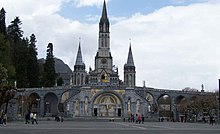Rosary Basilica
| Basilica of Our Lady of the Rosary of Lourdes Notre Dame du Rosaire de Lourdes (French) |
|
|---|---|

The Rosary Basilica from across Rosary Square. Note the modified façade.
|
|
| Basic information | |
| Location |
|
| Geographic coordinates | 43°05′51″N 00°03′27″W / 43.09750°N 0.05750°WCoordinates: 43°05′51″N 00°03′27″W / 43.09750°N 0.05750°W |
| Affiliation | Roman Catholic |
| Year consecrated | 1901 |
| Ecclesiastical or organizational status | Minor basilica |
| Website | Official website |
| Architectural description | |
| Architect(s) | Leopold Hardy |
| Architectural type | Church |
| Architectural style | Neo-Byzantine |
| Groundbreaking | 1883 |
| Completed | 1889 |
| Specifications | |
| Direction of façade | E |
| Capacity | 1500 |
| Length | 55 metres (180 ft) |
| Width | 50 metres (160 ft) |
The Basilica of Our Lady of the Rosary (French: Notre Dame du Rosaire de Lourdes) is a Roman Catholic church and minor basilica within the Sanctuary of Our Lady of Lourdes in France. Its main theme is a celebration and depiction of the Rosary.
The Rosary Basilica is the third of the churches to be completed on the site (after the Crypt and the Upper Basilica). It was designed by architect Leopold Hardy and completed in 1899. It was consecrated in 1901 and has a capacity of 1,500 worshippers. Its style is influenced by Byzantine architecture.
In 2006-7 the interior and exterior of the basilica were extensively renovated and the mosaics (many of which were deteriorating) were restored.
The nave is open and circular, surmounted by a dome. The dome contains sixteen circular stained glass windows. The fifteen spaces between these windows signify the fifteen decades of the traditional rosary.
The nave is surrounded by fifteen smaller side chapels, one for each of the traditional Mysteries of the Rosary. On the left of the nave are found the Joyful Mysteries; in the centre behind the sanctuary are the Sorrowful Mysteries, and to the right are the Glorious Mysteries.
Each side-chapel comprises a large mosaic with a central image depicting the theme of that Mystery, and an inscription in Latin. Incorporated within the larger image may be smaller images of related themes. For example, the side chapel directly behind the altar contains a depiction of the Crowning with Thorns, which is surmounted by an image of the Ark of the Covenant (see figure).
Most of the mosaics bear a date of around 1900. In each side-chapel is a small altar bearing six candles.
...
Wikipedia
